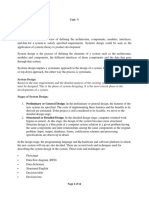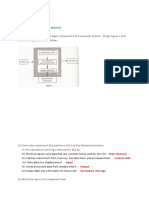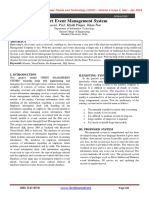Design (AQA) - Isaac Computer Science
Design (AQA) - Isaac Computer Science
Uploaded by
khinhtethtet khaingCopyright:
Available Formats
Design (AQA) - Isaac Computer Science
Design (AQA) - Isaac Computer Science
Uploaded by
khinhtethtet khaingOriginal Description:
Original Title
Copyright
Available Formats
Share this document
Did you find this document useful?
Is this content inappropriate?
Copyright:
Available Formats
Design (AQA) - Isaac Computer Science
Design (AQA) - Isaac Computer Science
Uploaded by
khinhtethtet khaingCopyright:
Available Formats
2/5/24, 10:21 AM Design (AQA) — Isaac Computer Science
Home Design (AQA)
Design (AQA)
The design stage is vital to the success of the project. You don’t have to design everything in detail at the outset, but if you start developing without
considering the design beforehand, you are likely to waste a lot of time.
https://isaaccomputerscience.org/concepts/prog_cw k_design_aqa?examBoard=all&stage=all 1/16
2/5/24, 10:21 AM Design (AQA) — Isaac Computer Science
A Level A high-level overview of how different parts of the system interact
This high-level overview will depend on the type of system that you are developing and it is up to you to pick the most appropriate method(s).
These are some commonly used techniques:
IPSO chart IPSO charts are really useful for identifying the classic
transformation of data into information. For each output,
you should think about what data is required, how it is processed,
and any associated storage.
IPSO charts are one of the most useful techniques for
prompting you to articulate what else needs to be designed.
Example
Example of two rows in an IPSO chart about the social networking system:
Input Process Storage Output
Student details: - Validate input Student table - Message stating
- Encrypt password (database) registration
- Name - Generate email successful
- Tutor - Encrypted
- Email password
- Username - Email with a
- Password verification link
Triggered by button on Sum of all Array of records Line chart
reporting screen registration over the (int)
last year, subtotalled
by month
Hierarchy chart Hierarchy charts can show how a large program will be split
into subroutines. Hierarchy charts can also show the
interface (parameters and return values) between
subroutines.
Example
https://isaaccomputerscience.org/concepts/prog_cw k_design_aqa?examBoard=all&stage=all 2/16
2/5/24, 10:21 AM Design (AQA) — Isaac Computer Science
Figure 1: Example of a hierarchy chart
Page navigation Page navigation shows how the different pages/forms that make up your
system are linked and how each page/form can be reached.
Example
Figure 2: Example of page navigation
https://isaaccomputerscience.org/concepts/prog_cw k_design_aqa?examBoard=all&stage=all 3/16
2/5/24, 10:21 AM Design (AQA) — Isaac Computer Science
System flowchart System flowcharts are very useful for games and control systems (e.g. for
a robot) to show the overall flow of play/control. The system
flowchart is a graphical representation of the major
stages within the system. It is an abstraction in that it often
will not include minor parts of the system.
Example
Figure 3: Example of a system flowchart
https://isaaccomputerscience.org/concepts/prog_cw k_design_aqa?examBoard=all&stage=all 4/16
2/5/24, 10:21 AM Design (AQA) — Isaac Computer Science
https://isaaccomputerscience.org/concepts/prog_cw k_design_aqa?examBoard=all&stage=all 5/16
2/5/24, 10:21 AM Design (AQA) — Isaac Computer Science
A Level User interface
Most systems have a graphical user interface. GUIs can be time-consuming to produce, so a clear design is essential. Whatever type of
interface you envisage, start by thinking carefully about what data needs to be captured. It is useful to make a list of everything that needs to be
input and how you can minimise data input errors.
Here is an example of the data required for initial user registration in the social network system:
Data item Data type Validation/Restrictions
Student name Text - Required
- Letters and spaces only
Tutor group Text - Required
- Select from drop-down list
Email address Text - Required
- Use regular expression to check
valid format
- Will also be validated by having
to click on the link in the email
Username Text - Required
- Must be unique (on system)
Password Text - Required
- Must be at least 8 characters
- Must contain at least one each
of the following: uppercase letter, lowercase
letter, number, and special
character.
- Verified by double entry
Note: All of the data types in this table are described (correctly) as text. You will usually have a wide range of data types, e.g. date, integer,
decimal, Boolean, etc. You can use generic data types or, at this stage, use types specific to the programming language/database system that
you plan to use.
Interface design
Once you have identified all of the data that needs to be captured, you can design your interface. AQA do allow you to include screen captures of
your actual interface as evidence, but clear hand-drawn sketches are fine too. To avoid wasting time and effort, you should design your interfaces
before you start to make them. Annotate the design clearly to draw attention to design aspects as shown in the example below.
https://isaaccomputerscience.org/concepts/prog_cw k_design_aqa?examBoard=all&stage=all 6/16
2/5/24, 10:21 AM Design (AQA) — Isaac Computer Science
Figure 4: Example of annotated GUI design
Next, you should consider the system outputs. Look back at the system requirements and identify the information that the system has to
produce. How will this information be presented? In many instances, it will be displayed on a screen, but outputs can be in many other forms.
Some outputs, such as an email, have a fairly standard layout. Reports from databases are often in table form. Graphs can take many forms.
Hardware projects may have physical outputs, such as lights or movement.
https://isaaccomputerscience.org/concepts/prog_cw k_design_aqa?examBoard=all&stage=all 7/16
2/5/24, 10:21 AM Design (AQA) — Isaac Computer Science
Figure 5: Example of annotated design for a report
Figure 6: Example of annotated design for a graph
https://isaaccomputerscience.org/concepts/prog_cw k_design_aqa?examBoard=all&stage=all 8/16
2/5/24, 10:21 AM Design (AQA) — Isaac Computer Science
A Level Permanent data storage
Most systems store data permanently (or at least until someone decides to delete it). If the data stored includes personal data, it is important that
the system has the functionality to delete data so that it complies with GDPR.
You have several choices for data stores. You may wish to choose a storage method that contributes to the complexity of the project, but make
sure that it is appropriate for the storage task.
Type Suitable for Design
(examples)
Text files Simple flat files with no Record structure — fixed
requirement to directly length fields or CSV
access single records
Binary files - Structured data that only Record structure
needs to be retrieved and read
into your system (e.g. game
data)
- Image data
Files organised for Very large volumes of data Record structure
direct access where specific records need Access mechanism
to be retrieved directly
Database - Large volumes of data E-R diagram (normalised
- Data that needs to be table design)
searched frequently DDL statements
Database design Text files Binary files Files organised for direct access
Example design work: E-R diagram (relations normalised)
Figure 7: Example of annotated design for a graph
Example design work: DDL statement
https://isaaccomputerscience.org/concepts/prog_cw k_design_aqa?examBoard=all&stage=all 9/16
2/5/24, 10:21 AM Design (AQA) — Isaac Computer Science
CREATE TABLE Student(
StudentId CHAR(8),
Surname VARCHAR(40) NOT NULL,
FirstName VARCHAR (40) NOT NULL,
Dob DATE NOT NULL,
TutorId CHAR(4) NOT NULL,
FOREIGN KEY (Tutorid) REFERENCES Tutor (Tutorid),
PRIMARY KEY (StudentId));
Student ID Surname First name DOB Tutor ID
16 bytes 80 bytes 80 bytes 20 bytes 8 bytes
A text file can have fixed- or variable-length records. Variable-length records are more space-efficient and you only need to decide on the
order of fields and how each field will be delimited. A common system is CSV (comma-separated variable); this system is also useful if
the data needs to be transferred to other systems, such as a word-processing system for mail merge or a spreadsheet for graphing. You
could also store your data as a JSON or XML file. It makes sense to use industry standard formats if your data is to be shared with other
systems (or if your data originates from another system).
Example design work: Text file
File structure: student.csv
Student ID Surname First name DOB Tutor ID
Each field will be variable-length and separated by a comma.
Binary files are the most efficient way of storing data that only needs to be written and read by your own programs. It will save you having
to format and reformat data to fit a specific file structure. Again, you will need to research how your chosen programming language
handles files. In Python, the pickle module will allow you to take standard data structures and store them directly into a binary file.
There are 'standard' binary file formats, such as JPEG for image files. If you choose a standard format, you will need to research the way
in which data is laid out, and you will probably be able to find library code to read and write these files in the correct format. If you are
creating your own (proprietary) format, avoid using a standard file extension because it might be associated with a particular software
package. For example, if you use the file extension XLS, your operating system would almost certainly associate it with Microsoft Excel.
Example design work: Binary file
File structure: gamedata.xyz
The game data will be stored in a list that comprises:
Player_1_hand
Player_2_hand
Card_deck
Player_1_score
Player_2_score
The design for each of these structures can be found in the internal data storage section.
When you plan the design of a file organised for direct access, you need to research how the programming language will access the file
directly. For example, in Python, the 'file seek' method allows you to start reading or writing at a particular point. This point would be
calculated by specifying position = record_size * record_number.
Your first design choice will be how the records will be laid out. For direct access, your records need to be fixed-size, so you will need to
specify a fixed-length character encoding scheme for your characters, e.g. UCS-2 which uses 16 bits (2 bytes) to encode each character.
Example design work: file organised for direct access
File structure: student.bin encoding scheme UCS-2
Your second design choice will relate to how you will find the record number to directly access a specific record. You will probably use a
hash table, so you will need to design a hashing algorithm and an algorithm for dealing with collisions.
https://isaaccomputerscience.org/concepts/prog_cw k_design_aqa?examBoard=all&stage=all 10/16
2/5/24, 10:21 AM Design (AQA) — Isaac Computer Science
https://isaaccomputerscience.org/concepts/prog_cw k_design_aqa?examBoard=all&stage=all 11/16
2/5/24, 10:21 AM Design (AQA) — Isaac Computer Science
A Level Internal data storage
You will also store data for processing while your program is running. Some systems will only have runtime data (for example, in a game where
there is no feature to save and resume playing later). Most systems will use at least one type of data structure. This may be a simple one- or two-
dimensional array, or it could be an abstract data type such as a queue, stack, or hash table. Simple one- or two-dimensional arrays will not
attract marks for complexity. Look at the Data Structures theory topic and identify opportunities to use more complex structures (making sure that
they are appropriate for the task).
You will need to produce an implementation design for each structure that you plan to use. For example, a queue could be implemented as an
array of records, or a tree as three one-dimensional arrays.
Class diagrams Example
OOP systems will need class diagrams. This will involve identifying the attributes and methods for each class. You will also need to
consider whether properties should be private, public, or protected. The relationship between the classes (inheritance, aggregation,
composition) can be shown on a well-developed UML diagram.
Figure 8: Example design work: UML diagram
Design work: array
The seating in the hall is configured with 20 rows of 100 seats. This will be stored as a two-dimensional array. A position (seat) in the hall
will be referenced by its row letter (A to T) and seat number (1 to 100). The element in the array will contain the booking reference (so that
the booking details can be retrieved from the database when needed).
When the user specifies a seat, e.g. G33, we can get the relevant indices as follows:
row = CHAR_To_NUM (letter) - 64
seat = number - 1
To access the booking reference for a particular position (seat) in the hall, we can specify:
booking_ref = hall [row] [seat]
https://isaaccomputerscience.org/concepts/prog_cw k_design_aqa?examBoard=all&stage=all 12/16
2/5/24, 10:21 AM Design (AQA) — Isaac Computer Science
https://isaaccomputerscience.org/concepts/prog_cw k_design_aqa?examBoard=all&stage=all 13/16
2/5/24, 10:21 AM Design (AQA) — Isaac Computer Science
A Level Algorithms
Your algorithms are another key area on which the complexity of your system will be judged. The person marking your project will be looking for
evidence that you have designed, implemented, and tested complex algorithms, such as a graph traversal and/or complex SQL statements that
join tables and use parameters (user-supplied values) in the statement selection criteria. Not every algorithm will be complex and you must take
care not to contrive overly complex solutions — make sure your design ideas are proportionate to the size of the problem. For example, avoid
specifying a merge sort if you just need to sort a list of 10 items.
In this section of design, you need to specify the algorithm for each key process. A key process can be defined as one that will allow you to fulfil
your objectives. For example:
Encrypt the password
Select the number of users that have registered in the last 12 months, subtotalled by month
Select users with matching interests
Calculate the degree of match between users
If you have an OOP system, you will devise an algorithm for each substantial method.
Algorithms can be expressed in pseudocode, in structured English, or as flowcharts. You can write SQL statements if you will be working with a
database.
Pseudocode Structured English Flowchart SQL
Purpose: To calculate a grade
FOREACH student
IF score >= 90 THEN
grade = “A”
ELSE IF score >= 80 AND score < 90 THEN
grade = “A”
ELSE IF score >= 70 AND score < 80 THEN
grade = “B”
ELSE IF score >= 60 AND score < 70 THEN
grade = “C”
ELSE IF score >= 50 AND score < 60 THEN
grade = “D”
ELSE IF score >= 40 AND score < 50 THEN
grade = “E”
ELSE
grade = “U”
END IF
END FOR
Purpose: To validate an email address
Regular expression is (^[a-zA-Z0-9_.+-]+@[a-zA-Z0-9-]+\.[a-zA-Z0-9-.]+$)
If email is blank then
Report error "Email address must not be left blank"
Else if email does not match regular expression then
Report error "Email is not in a valid format"
Else email is valid
Purpose: To validate a username
https://isaaccomputerscience.org/concepts/prog_cw k_design_aqa?examBoard=all&stage=all 14/16
2/5/24, 10:21 AM Design (AQA) — Isaac Computer Science
Figure 9: Example of algorithm as a flowchart
Purpose: To get details of the last 12 months' registrations grouped by month
SELECT count(*)
FROM student
WHERE
regdate > = DATE_SUB(DATE_FORMAT(CURRENT_DATE,'%Y-%m-01'),INTERVAL 1 YEAR)
AND verified = True
GROUP BY Month(regdate)
https://isaaccomputerscience.org/concepts/prog_cw k_design_aqa?examBoard=all&stage=all 15/16
2/5/24, 10:21 AM Design (AQA) — Isaac Computer Science
All teaching materials on this site are available under the Open Government Licence v3.0, except where otherwise stated.
https://isaaccomputerscience.org/concepts/prog_cw k_design_aqa?examBoard=all&stage=all 16/16
You might also like
- Different Diagrams of Online Shopping SystemDocument9 pagesDifferent Diagrams of Online Shopping SystemRXT STORMNo ratings yet
- Visualising Software Architecture With The c4 Model Full DayDocument201 pagesVisualising Software Architecture With The c4 Model Full DayLuis Fajardo100% (3)
- CIS 105 Final Exam - Review Sheet Computer ConceptsDocument2 pagesCIS 105 Final Exam - Review Sheet Computer ConceptsS PNo ratings yet
- Final Exam in Empowerment TechnologiesDocument3 pagesFinal Exam in Empowerment TechnologiesPangangan NHS75% (4)
- Installation Guide: Protecttoolkit CDocument46 pagesInstallation Guide: Protecttoolkit CLyuben BahtarlievNo ratings yet
- NEC IS007 ISM6 2 Config Setting Tool Users Manual GUIDocument529 pagesNEC IS007 ISM6 2 Config Setting Tool Users Manual GUISid GrgNo ratings yet
- Taskmatrix - Ai: Completing Tasks by Connecting Foundation Models With Millions of ApisDocument27 pagesTaskmatrix - Ai: Completing Tasks by Connecting Foundation Models With Millions of ApisalkanarynetNo ratings yet
- Visualization of Sorting Algorithm12345khhdfkshdDocument12 pagesVisualization of Sorting Algorithm12345khhdfkshdSachin KumarNo ratings yet
- Design of A Pen-Based Electric Diagram Editor BaseDocument12 pagesDesign of A Pen-Based Electric Diagram Editor Basefiliman219No ratings yet
- Different Diagrams of Online Shopping SystemDocument9 pagesDifferent Diagrams of Online Shopping SystemRXT STORMNo ratings yet
- Class 8 ComputerDocument9 pagesClass 8 ComputerAARUSHI EDUCATIONAL CHANNELNo ratings yet
- Aotb2019 Visualising Software Architecture With The c4 ModelDocument86 pagesAotb2019 Visualising Software Architecture With The c4 ModelLeonardo Favio Caraguay CaraguayNo ratings yet
- Zachman FrameworkDocument8 pagesZachman FrameworkAbhimauryaNo ratings yet
- Structure (Data Structures) - JavatpointDocument6 pagesStructure (Data Structures) - Javatpointmadsamael004No ratings yet
- Deep Learning PaperDocument6 pagesDeep Learning PaperThunderslapNo ratings yet
- DESC: A Hardware-Software Codesign Methodology For Distributed Embedded SystemsDocument15 pagesDESC: A Hardware-Software Codesign Methodology For Distributed Embedded SystemsANNAPUREDDY RAVINDER REDDYNo ratings yet
- 07 IismDocument49 pages07 IismLuminita Maria TrifuNo ratings yet
- ETCW03Document3 pagesETCW03Editor IJAERDNo ratings yet
- ISD LAB06-ClassDesignDocument11 pagesISD LAB06-ClassDesignTú PhạmNo ratings yet
- Visualizing Software ArchitectureDocument1 pageVisualizing Software ArchitectureIvan Georgiev0% (1)
- A Comparison of Performance and AccuracyDocument14 pagesA Comparison of Performance and AccuracyUmer SaeedNo ratings yet
- Week 2 Presentation PlanDocument2 pagesWeek 2 Presentation PlanDumbydoreNo ratings yet
- Applied SciencesDocument51 pagesApplied SciencesPan TauNo ratings yet
- 1.3 Sofware Architecture DocumentationDocument22 pages1.3 Sofware Architecture Documentation22mt0045No ratings yet
- Responsibilities: Real Time Analytics Processing SpecialistDocument20 pagesResponsibilities: Real Time Analytics Processing SpecialistShubham RaizadaNo ratings yet
- A Survey On Software Suites For Data Mining, Analytics and Knowledge DiscoveryDocument6 pagesA Survey On Software Suites For Data Mining, Analytics and Knowledge DiscoveryInternational Journal of computational Engineering research (IJCER)No ratings yet
- Assignment03 ClassDesignDocument11 pagesAssignment03 ClassDesignHoài LinhNo ratings yet
- Travel Agency C++ Project ReportDocument21 pagesTravel Agency C++ Project ReportvarshaNo ratings yet
- Metro Flow ChartDocument8 pagesMetro Flow ChartShaival PimplikarNo ratings yet
- 2021arch 1 IntroDocument20 pages2021arch 1 IntrowowsoshinyNo ratings yet
- Software Engineering Project ReportDocument5 pagesSoftware Engineering Project ReportRana afaqNo ratings yet
- A Bayesian Model For Recognizing Handwritten Mathematic - 2015 - Pattern RecogniDocument13 pagesA Bayesian Model For Recognizing Handwritten Mathematic - 2015 - Pattern RecogniSwarnalathaNo ratings yet
- 2023arch 1 Ch0 IntroDocument21 pages2023arch 1 Ch0 Intro1056754379No ratings yet
- Visualizing Dataflow Graphs of Deep Learning Models in TensorflowDocument12 pagesVisualizing Dataflow Graphs of Deep Learning Models in TensorflowRamdani AgusmanNo ratings yet
- CS322 - Computer Architecture (CA) : Spring 2019 Section V3Document57 pagesCS322 - Computer Architecture (CA) : Spring 2019 Section V3TANZEELA SHAKEELNo ratings yet
- Dsa Lab ReportDocument5 pagesDsa Lab ReportAbdul WahabNo ratings yet
- Evaluating Gather and Scatter Performance On Cpus and Gpus: Patrick Lavin Jeffrey Young Richard VuducDocument14 pagesEvaluating Gather and Scatter Performance On Cpus and Gpus: Patrick Lavin Jeffrey Young Richard VuducSudip DasNo ratings yet
- System Design BasicsDocument2 pagesSystem Design BasicstaffNo ratings yet
- A Model Based Approach To Workflow Management Using Knowledge GraphsDocument32 pagesA Model Based Approach To Workflow Management Using Knowledge GraphsRakshit MittalNo ratings yet
- Pharmacy Management SystemDocument37 pagesPharmacy Management SystemSiva Kumar75% (4)
- Assignment No.3Document15 pagesAssignment No.3bihod71717No ratings yet
- Learning To Compare Image Patches Via Convolutional Neural NetworksDocument9 pagesLearning To Compare Image Patches Via Convolutional Neural NetworksSiva Jyothi ChandraNo ratings yet
- Inputs To System DesignDocument8 pagesInputs To System Design555bsyadav555No ratings yet
- Articol Disteibuted Data ProcessingDocument9 pagesArticol Disteibuted Data ProcessingAlexandru StefanNo ratings yet
- FIRST: Fast Interactive A Ributed Subgraph MatchingDocument10 pagesFIRST: Fast Interactive A Ributed Subgraph MatchingsunnyxingNo ratings yet
- CS-practical Notes (For A SATAR)Document15 pagesCS-practical Notes (For A SATAR)Muhammad AnassNo ratings yet
- EEL6825-Character Recognition Algorithm Using Correlation.Document8 pagesEEL6825-Character Recognition Algorithm Using Correlation.roybardhanankanNo ratings yet
- VLSI Design FlowDocument10 pagesVLSI Design Flowuday93No ratings yet
- System Design: 3.1 Process ModelDocument4 pagesSystem Design: 3.1 Process ModelEr Mukesh MistryNo ratings yet
- System Architecture Modeling For Electronic Systems Using MathWorks System Composer and SimulinkDocument10 pagesSystem Architecture Modeling For Electronic Systems Using MathWorks System Composer and SimulinkOnur OzdemirNo ratings yet
- Source Code Analysis - An Overview: Radoslav Kirkov, Gennady AgreDocument18 pagesSource Code Analysis - An Overview: Radoslav Kirkov, Gennady AgreEmil StankovNo ratings yet
- Unit V PDFDocument12 pagesUnit V PDFRoshan ShresthaNo ratings yet
- Training Access BasicsDocument29 pagesTraining Access BasicsSultan Maul MaulanaNo ratings yet
- Caie Igcse Computer Science 0478 Practical 65c92cddd3a96650b21a96de 502Document15 pagesCaie Igcse Computer Science 0478 Practical 65c92cddd3a96650b21a96de 502nafawi1685No ratings yet
- Summer 2020 CSE327 - MidtermDocument6 pagesSummer 2020 CSE327 - MidtermNafiz SheikhNo ratings yet
- Computer Institute Management System PPT PresentationDocument27 pagesComputer Institute Management System PPT PresentationAsmita PisalNo ratings yet
- BCA 1st Programming in CaaaDocument130 pagesBCA 1st Programming in CaaaKrishna SahuNo ratings yet
- Constructing Parallel Coordinates Plot For ProblemDocument7 pagesConstructing Parallel Coordinates Plot For ProblemAntonella AntoniniNo ratings yet
- Flow Chart:: Flowchart SymbolsDocument9 pagesFlow Chart:: Flowchart SymbolsnehaNo ratings yet
- Incremental Schema MatchingDocument4 pagesIncremental Schema MatchingvthungNo ratings yet
- Algorithms and Data Structures: An Easy Guide to Programming SkillsFrom EverandAlgorithms and Data Structures: An Easy Guide to Programming SkillsNo ratings yet
- C# Data Structures and Algorithms: Harness the power of C# to build a diverse range of efficient applicationsFrom EverandC# Data Structures and Algorithms: Harness the power of C# to build a diverse range of efficient applicationsNo ratings yet
- Lie Lesson 2-7 NotesDocument32 pagesLie Lesson 2-7 NotesBARRIENTOS, MARIE NICOLENo ratings yet
- Oracle Golden Gate Troubleshooting and Tuning DocumentDocument147 pagesOracle Golden Gate Troubleshooting and Tuning Documentkr_ocpNo ratings yet
- Excel InterfaceDocument5 pagesExcel InterfacesonamNo ratings yet
- Basic Application SoftwareDocument3 pagesBasic Application SoftwareprinceNo ratings yet
- Adams 2020 Getting Started Using Adams CarDocument120 pagesAdams 2020 Getting Started Using Adams CarDanish HassanNo ratings yet
- May 2010 Infor Tech Past Paper 2Document12 pagesMay 2010 Infor Tech Past Paper 2Tamera GreenNo ratings yet
- Konelab PRIME 30 Service ManualDocument282 pagesKonelab PRIME 30 Service ManualWiener cesar RodriguezNo ratings yet
- Introduction To Programming With Mathpiper VDocument140 pagesIntroduction To Programming With Mathpiper VthemrnutzNo ratings yet
- 04 - Elms - Activity - 1 (Management Information Systems)Document3 pages04 - Elms - Activity - 1 (Management Information Systems)Emjey MonterdeNo ratings yet
- SRS Document For Movie Ticket Booking SystemDocument35 pagesSRS Document For Movie Ticket Booking SystemMohammed ArfathNo ratings yet
- Interface Management in Mega Oil Refinery Projects: 1-AbstractDocument19 pagesInterface Management in Mega Oil Refinery Projects: 1-Abstract786tip786100% (1)
- SURFCAM 6 Whats NewDocument41 pagesSURFCAM 6 Whats Newmega xNo ratings yet
- The Zgui (R) Evolution - First Hands On Experience and Best PracticesDocument60 pagesThe Zgui (R) Evolution - First Hands On Experience and Best PracticesArun Kumar BNo ratings yet
- BTS Commissioning: Prepared & Presented By: Thushara KarunarathnaDocument75 pagesBTS Commissioning: Prepared & Presented By: Thushara KarunarathnaErangaNo ratings yet
- Beamprop Rsoft Training MaterialDocument280 pagesBeamprop Rsoft Training Materialhaotianhu213No ratings yet
- Load Bank Operating InstructionsDocument194 pagesLoad Bank Operating InstructionsJonathan Javier Ceballos Bonilla0% (1)
- CAPLQuickstart Generic 2018 FinalDocument30 pagesCAPLQuickstart Generic 2018 FinalManya SundarNo ratings yet
- SALOME 7 4 0 Release NotesDocument40 pagesSALOME 7 4 0 Release NotesJoseph BookerNo ratings yet
- Oracle Process Manufacturing PDFDocument110 pagesOracle Process Manufacturing PDFkumar_amit_990% (2)
- Adams View HelpDocument260 pagesAdams View HelpVolkan UzerNo ratings yet
- Introduction To Microsoft ExcelDocument6 pagesIntroduction To Microsoft ExcelDiana LinatocNo ratings yet
- EClass Software User Manual Android AppDocument27 pagesEClass Software User Manual Android AppHERLINDANo ratings yet
- Human Computer Interaction - Brief Intro - The Encyclopedia of Human-Computer Interaction, 2nd EdDocument1 pageHuman Computer Interaction - Brief Intro - The Encyclopedia of Human-Computer Interaction, 2nd EdSENTHIL RNo ratings yet
- (IJCST-V4I2P29) :assist - Prof. Khalil Pinjari, Khan NurDocument4 pages(IJCST-V4I2P29) :assist - Prof. Khalil Pinjari, Khan NurEighthSenseGroupNo ratings yet
- RHUB3908 Hardware Maintenance GuideDocument22 pagesRHUB3908 Hardware Maintenance Guideapiruck sukjingNo ratings yet
- FXpDia (Modify)Document476 pagesFXpDia (Modify)bimbim1611100% (1)

























































































